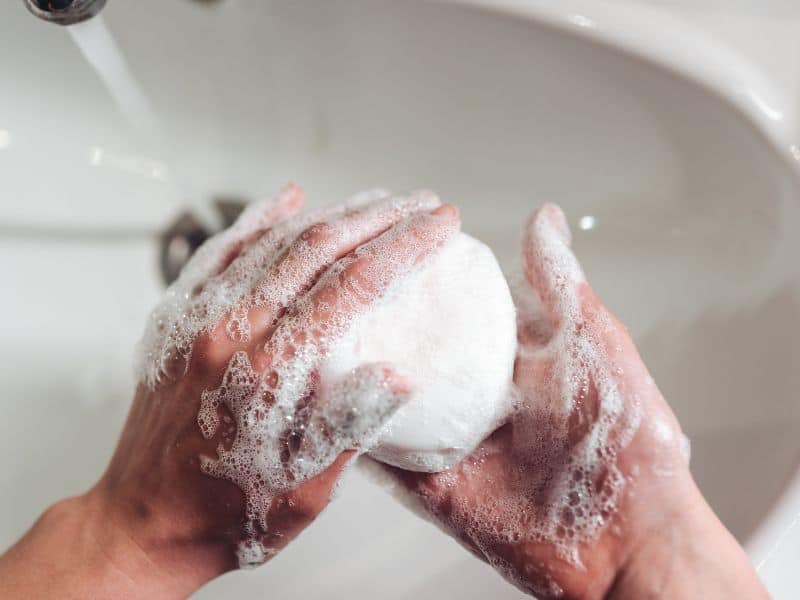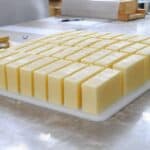One of the biggest challenges with homemade soaps can be getting it to lather properly. Fortunately, there are some simple tricks for making sure that your homemade soap lathers up nicely every time. We are going to look at some easy ways to make sure that your homemade soap produces a luxurious lather each and every time!
You can make homemade soap lather more by adding additives such as sugar, coconut oil, sodium lactate, or even beer or milk can increase the lather of homemade soap. These ingredients work to produce a rich and creamy lather.
If you’re not sure which additives to use, then no worries! We are going to get into additives and techniques you can use in this article, but first… Let’s take a close look at how lather works.
How Soap Lather Works
Soap lather is the bubbly, foamy, soap suds substance created when soap is mixed with water and agitated. It is formed by the interaction of surfactant molecules in the soap with water molecules. Surfactants have a hydrophobic (water-hating) tail and a hydrophilic (water-loving) head.
When soap is added to water, the hydrophobic tails of the surfactants cluster together, forming micelles with their hydrophilic heads facing outwards. As the water is agitated, the micelles break apart, creating the characteristic lather.
The quality and quantity of lather produced depend on factors such as the type and amount of surfactants used, water temperature, and water hardness.
The lather plays an essential role in the cleansing process by helping to lift and remove dirt and oils from the skin.
How to Make Melt and Pour Soap Lather More
While the pre-made soap base already contains surfactants, which are the ingredients that create lather, you can add additional ingredients to improve lather.
Here are some techniques and ingredients to try:
- Coconut Oil: Coconut oil creates a rich, fluffy lather. Add 1-2 tablespoons of melted coconut oil per pound of soap base to improve lather.
- Castor Oil: Castor oil adds silkiness and a creamy lather to soap. Add 1-2 tablespoons of melted castor oil per pound of soap base to improve lather.
- Sodium Lactate: Sodium lactate is a liquid salt that can improve the hardness and lather of soap. Add 1 teaspoon of sodium lactate per pound of soap base to improve lather.
- Increase Surface Area: Use a mold with more surface area to create more lather. A shallow mold with a larger surface area will create more lather than a deep mold with a smaller surface area.
- Avoid Overheating: Don’t overheat the soap base or it may destroy some of the lathering properties. Melt the soap base slowly and gently, stirring frequently to prevent overheating.
- Use Good Water: Hard water can interfere with lather, so consider using distilled or filtered water to make your soap.
By incorporating these techniques and ingredients, you can improve the lather of your melt and pour soap and create a more luxurious lathering experience.
How to Make Hot and Cold Process Soap Lather More
While the process of creating lather in cold process soap is a bit more complicated than in melt and pour soap, there are still several techniques and ingredients that can improve lather.
Here’s how to make cold-process soap lather more:
- Use the right oils: The type of oils you use in your soap can greatly impact lather. Coconut oil, palm oil, and castor oil are all known for creating a rich lather. Consider using a higher percentage of these oils in your soap recipe.
- Use Sodium Lactate: Sodium lactate is a liquid salt that can help harden soap and create a better lather. Add 1 teaspoon of sodium lactate per pound of oils to your soap recipe.
- Add sugar: Sugar can create a creamy, luxurious lather in soap. Add 1 teaspoon of sugar per pound of oils to your soap recipe.
- Use the right water temperature: Using water that is too hot or too cold can impact lather. Use water that is between 90-110°F (32-43°C) when making your soap.
- Allow for a longer cure time: The longer your soap cures, the better the lather will be. Allow your soap to cure for 4-6 weeks before using.
- Use a stick blender: Using a stick blender to mix your soap can create a more luxurious lather. Blend your soap until it reaches a light trace, then stop to avoid over-blending.
How to Make Homemade Bodywash Lather More
If you prefer using a body wash over bar soap, you may be wondering how to improve its lather.
Here are some tips for making homemade body wash lather more:
- Use the right surfactants: Surfactants are the ingredients that create lather in body wash. Using a combination of mild surfactants like decyl glucoside and cocamidopropyl betaine can create a nice lather without stripping the skin of natural oils.
- Add salt: Adding salt to your body wash can help create a thicker lather. Dissolve 1-2 teaspoons of salt per cup of body wash in warm water and mix it into your body wash.
- Add glycerin: Glycerin is a humectant that can help draw moisture to the skin and create a more luxurious lather. Add 1-2 teaspoons of glycerin per cup of body wash to improve lather.
- Use a foaming dispenser: A foaming dispenser can help create more lather with less product. Simply add your body wash to a foaming dispenser and pump to create a rich lather.
Experiment with different surfactants, additives, and application methods to find what works best for you.
Benefits of Soap Lather
Some of the benefits of soap lather include:
- Lifts dirt and oil: Lather helps to lift dirt and oil from the skin’s surface, allowing them to be washed away with water.
- Exfoliates: The physical action of lather and bubbles can help to exfoliate the skin, removing dead skin cells and promoting a brighter, smoother complexion.
- Moisturizes: Soap lather can help to moisturize the skin by trapping water and preventing moisture loss.
- Enhances fragrance: Lather can help to release the fragrance of scented soaps, providing a more enjoyable sensory experience.
- Provides a sense of cleanliness: The presence of lather can give a visual indication of the cleansing process and provide a psychological sense of cleanliness.
Overall, the benefits of soap lather make it an essential component of the cleansing process and a key factor in achieving clean and healthy skin.
Techniques for Making Soap Lather More
Here are some effective techniques for making soap lather more:
- Increase the amount of soap used: Adding more soap to your routine can create a richer lather.
- Use warm water: Warmer water can help to activate and enhance the lather.
- Agitate the water: Scrubbing or agitating the soap and water mixture can help to create a frothy, bubbly lather.
- Choose soap with the right ingredients: Look for soaps with ingredients such as coconut oil, castor oil, or shea butter, which can help to create a richer, creamier lather.
- Use a loofah or washcloth: Using a loofah or washcloth can help to create friction, which can increase the amount and quality of lather.
- Let the soap sit: Allowing the soap to sit on your skin for a few moments before rinsing can help to create a richer lather.
Use these techniques and create a more satisfying and effective lather when washing your skin.
Troubleshooting Common Lather Problems
While soap lather is generally a beneficial component of the cleansing process, there can be problems that arise when trying to create the perfect lather.
Here are some common lather problems and ways to troubleshoot them:
- Thin or watery lather: This may be due to using too little soap or using water that is too hot. Try adding more soap or using cooler water.
- No lather at all: This can be caused by using hard water, which contains minerals that can interfere with lather formation. Using a water softener or adding a small amount of citric acid to the water can help.
- Too much lather: This can be caused by using too much soap or using soap that contains too many foaming agents. Try reducing the amount of soap used or switching to a soap with fewer foaming agents.
- Dry or tight feeling after washing: This can be caused by using soap that is too harsh or using water that is too hot. Switching to a gentler soap or using cooler water can help.
Natural Additive To Soap For Lots of Suds
There are several natural additives that can be used to create lots of suds in soap.
Coconut Milk
One of the most common is coconut milk. Coconut milk contains natural fats that can help create a rich, creamy lather in soap. Another option is to add honey to the soap mixture.
Honey
Honey is known for its ability to create a bubbly lather and can help to moisturize the skin.
Aloe Vera Gel
Aloe vera gel is also a popular choice for adding suds to soap. Aloe vera contains natural saponins, which are foaming agents that help to create a rich lather.
Oatmeal
Finally, oatmeal can be added to soap for a gentle exfoliating effect that can help to remove dead skin cells and promote healthy skin.
These natural additives can be easily incorporated into soap recipes to create a luxurious and sudsy lather that is both gentle and effective.
Frequently Asked Questions
Soap lather works by reducing the surface tension of water, allowing it to penetrate and break down oils and dirt on the skin.
Soap lather can help to cleanse and exfoliate the skin, remove dirt and oil, and leave the skin feeling refreshed and moisturized.
Thin or watery soap lather can be caused by using too little soap, using water that is too hot, or using soap that is low in foaming agents.
Too much soap lather can be caused by using too much soap or using soap that contains too many foaming agents.
You can troubleshoot dry or tight feeling skin after washing with soap by switching to a gentler soap or using cooler water.
Conclusion
In conclusion, soap lather can help to cleanse, exfoliate, and moisturize the skin. Its presence can add to the sensory experience of using soap and provide a visual indication of the cleansing process. Using the right techniques when making soap lather can help to create a richer, creamier lather that is more effective at cleaning and hydrating the skin.
If you encounter any problems with your soap lather, troubleshooting them is key to achieving optimal results. With these tips in mind, you’ll be on your way to creating a luxurious and satisfying lather every time!






